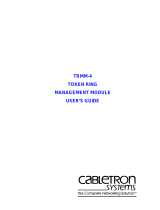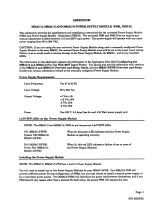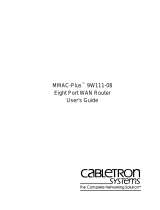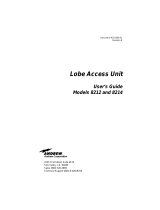
TRMIM-62A
TOKEN RING MEDIA INTERFACE MODULE
USER’S GUIDE


i
NOTICE
Cabletron Systems reserves the right to make changes in specifications and other information
contained in this document without prior notice. The reader should in all cases consult Cabletron
Systems to determine whether any such changes have been made.
The hardware, firmware, or software described in this manual is subject to change without notice.
IN NO EVENT SHALL CABLETRON SYSTEMS BE LIABLE FOR ANY INCIDENTAL,
INDIRECT, SPECIAL, OR CONSEQUENTIAL DAMAGES WHATSOEVER (INCLUDING BUT
NOT LIMITED TO LOST PROFITS) ARISING OUT OF OR RELATED TO THIS MANUAL OR
THE INFORMATION CONTAINED IN IT, EVEN IF CABLETRON SYSTEMS HAS BEEN
ADVISED OF, KNOWN, OR SHOULD HAVE KNOWN, THE POSSIBILITY OF SUCH
DAMAGES.
Copyright 1996 by Cabletron Systems, Inc,. P.O. Box 5005, Rochester, NH 03866-5005
All Rights Reserved
Printed in the United States of America
Order Number: 9031753-01 October 1996
SPECTRUM
,
LANVIEW
, and
FNB
are registered trademarks of Cabletron Systems, Inc.
MMAC
,
MMAC-M3FNB
,
MMAC-M8FNB TRMM
,
TRMMIM
,
and
TRMIM-62A
are trademarks of
Cabletron Systems, Inc.
All other product names mentioned in this manual may be trademarks or registered trademarks of
their respective companies.
Printed on Recycled Paper

NOTICE
ii
FCC NOTICE
This device complies with Part 15 of the FCC rules. Operation is subject to the following two
conditions: (1) this device may not cause harmful interference, and (2) this device must accept any
interference received, including interference that may cause undesired operation.
NOTE:
This equipment has been tested and found to comply with the limits for a Class A digital
device, pursuant to Part 15 of the FCC rules. These limits are designed to provide reasonable
protection against harmful interference when the equipment is operated in a commercial environment.
This equipment uses, generates, and can radiate radio frequency energy and if not installed in
accordance with the operator’s manual, may cause harmful interference to radio communications.
Operation of this equipment in a residential area is likely to cause interference in which case the user
will be required to correct the interference at his own expense.
WARNING:
Changes or modifications made to this device which are not expressly approved by the
party responsible for compliance could void the user’s authority to operate the equipment.
DOC NOTICE
This digital apparatus does not exceed the Class A limits for radio noise emissions from digital
apparatus set out in the Radio Interference Regulations of the Canadian Department of
Communications.
Le présent appareil numérique n’émet pas de bruits radioélectriques dépassant les limites applicables
aux appareils numériques de la class A prescrites dans le Règlement sur le brouillage radioélectrique
édicté par le ministère des Communications du Canada.
VCCI NOTICE
This equipment is in the 1st Class Category (information equipment to be used in commercial and/or
industrial areas) and conforms to the standards set by the Voluntary Control Council for Interference
by Information Technology Equipment (VCCI) aimed at preventing radio interference in commercial
and/or industrial areas.
Consequently, when used in a residential area or in an adjacent area thereto, radio interference may be
caused to radios and TV receivers, etc.
Read the instructions for correct handling.

NOTICE
iii
CABLETRON SYSTEMS, INC. PROGRAM LICENSE AGREEMENT
IMPORTANT:
Before utilizing this product, carefully read this License Agreement.
This document is an agreement between you, the end user, and Cabletron Systems, Inc. (“Cabletron”)
that sets forth your rights and obligations with respect to the Cabletron software program (the
“Program”) contained in this package. The Program may be contained in firmware, chips or other
media. BY UTILIZING THE ENCLOSED PRODUCT, YOU ARE AGREEING TO BECOME
BOUND BY THE TERMS OF THIS AGREEMENT, WHICH INCLUDES THE LICENSE AND
THE LIMITATION OF WARRANTY AND DISCLAIMER OF LIABILITY. IF YOU DO NOT
AGREE TO THE TERMS OF THIS AGREEMENT, PROMPTLY RETURN THE UNUSED
PRODUCT TO THE PLACE OF PURCHASE FOR A FULL REFUND.
CABLETRON SOFTWARE PROGRAM LICENSE
1. LICENSE
. You have the right to use only the one (1) copy of the Program provided in this
package subject to the terms and conditions of this License Agreement.
You may not copy, reproduce or transmit any part of the Program except as permitted by the
Copyright Act of the United States or as authorized in writing by Cabletron.
2. OTHER RESTRICTIONS. You may not reverse engineer, decompile, or disassemble the
Program.
3. APPLICABLE LAW. This License Agreement shall be interpreted and governed under the laws
and in the state and federal courts of New Hampshire. You accept the personal jurisdiction and
venue of the New Hampshire courts.
EXCLUSION OF WARRANTY AND DISCLAIMER OF LIABILITY
1. EXCLUSION OF
WARRANTY. Except as may be specifically provided by Cabletron in
writing, Cabletron makes no warranty, expressed or implied, concerning the Program (including
its documentation and media).
CABLETRON DISCLAIMS ALL WARRANTIES, OTHER THAN THOSE SUPPLIED TO
YOU BY CABLETRON IN WRITING, EITHER EXPRESSED OR IMPLIED, INCLUDING
BUT NOT LIMITED TO IMPLIED WARRANTIES OF MERCHANTABILITY AND
FITNESS FOR A PARTICULAR PURPOSE, WITH RESPECT TO THE PROGRAM, THE
ACCOMPANYING WRITTEN MATERIALS, AND ANY ACCOMPANYING HARDWARE.
2. NO LIABILITY FOR CONSEQUENTIAL DAMAGES. IN NO EVENT SHALL
CABLETRON OR ITS SUPPLIERS BE LIABLE FOR ANY DAMAGES WHATSOEVER
(INCLUDING, WITHOUT LIMITATION, DAMAGES FOR LOSS OF BUSINESS,
PROFITS, BUSINESS INTERRUPTION, LOSS OF BUSINESS INFORMATION, SPECIAL,
INCIDENTAL, CONSEQUENTIAL, OR RELIANCE DAMAGES, OR OTHER LOSS)
ARISING OUT OF THE USE OR INABILITY TO USE THIS CABLETRON PRODUCT,
EVEN IF CABLETRON HAS BEEN ADVISED OF THE POSSIBILITY OF SUCH
DAMAGES. BECAUSE SOME STATES DO NOT ALLOW THE EXCLUSION OR
LIMITATION OF LIABILITY FOR CONSEQUENTIAL OR INCIDENTAL DAMAGES, OR
ON THE DURATION OR LIMITATION OF IMPLIED WARRANTIES, IN SOME
INSTANCES THE ABOVE LIMITATIONS AND EXCLUSIONS MAY NOT APPLY TO
YOU.

NOTICE
iv
UNITED STATES GOVERNMENT RESTRICTED RIGHTS
The enclosed product (a) was developed solely at private expense; (b) contains “restricted computer
software” submitted with restricted rights in accordance with Section 52227-19 (a) through (d) of the
Commercial Computer Software - Restricted Rights Clause and its successors, and (c) in all respects
is proprietary data belonging to Cabletron and/or its suppliers.
For Department of Defense units, the product is licensed with “Restricted Rights” as defined in the
DoD Supplement to the Federal Acquisition Regulations, Section 52.227-7013 (c) (1) (ii) and its
successors, and use, duplication, disclosure by the Government is subject to restrictions as set forth in
subparagraph (c) (1) (ii) of the Rights in Technical Data and Computer Software clause at
252.227-7013. Cabletron Systems, Inc., 35 Industrial Way, Rochester, New Hampshire 03867-0505.

v
CONTENTS
CHAPTER 1 INTRODUCTION
1.1 Getting Help.................................................................................1-2
1.2 Document Conventions...............................................................1-2
1.3 Using This Manual.......................................................................1-2
1.4 TRMIM-62A Features..................................................................1-3
1.4.1 Active TCU Lobe Ports ...................................................1-3
1.4.2 Jumper-Selectable Ring Speed......................................1-4
1.4.3 Speed-Fault Protection...................................................1-4
1.4.4 Beaconing Protection......................................................1-4
1.4.5 TRMIM-62A Management ..............................................1-5
1.4.6 Visual Monitoring With LANVIEW LEDs.........................1-5
1.5 Related Manuals..........................................................................1-5
1.6 Recommended Reading..............................................................1-6
CHAPTER 2 REQUIREMENTS AND SPECIFICATIONS
2.1 Installation Guidelines .................................................................2-1
2.2 Management Module Requirements ...........................................2-2
2.3 Cabling Guidelines ......................................................................2-2
2.3.1 Maintaining Port/Cabling Impedance Matching ..............2-2
2.3.2 Recommended Lobe Lengths.........................................2-2
2.4 Setting The Ring Speed ..............................................................2-3
2.4.1 Management Configuration Overrides............................2-4
2.5 General Specifications.................................................................2-5
2.5.1 Safety..............................................................................2-5
2.5.2 Electromagnetic Compatibility (EMC).............................2-5
2.5.3 Physical ..........................................................................2-5
2.5.4 Environmental.................................................................2-5

CONTENTS
vi
CHAPTER 3 INSTALLATION
3.1 Unpacking And Handling The TRMIM-62A..................................3-1
3.2 Installing The TRMIM-62A ...........................................................3-2
3.3 Attaching Stations........................................................................3-4
3.4 Checking The Installation.............................................................3-6
CHAPTER 4 MONITORING AND TROUBLESHOOTING
4.1 Using LANVIEW LEDs.................................................................4-1
4.2 Troubleshooting The Network......................................................4-3
INDEX

1-1
CHAPTER 1
INTRODUCTION
Welcome to the
TRMIM-62A
Token Ring Media Interface Module
User’s Guide
. This manual describes how to configure, install, and attach
stations to the TRMIM-62A. It also describes how to monitor the
operational status of the module and how to troubleshoot any operational
or installation problems that may arise.
The TRMIM-62A (see Figure 1-1), is an IEEE 802.5 compliant Token
Ring Media Interface Module (MIM) providing 12 coaxial lobe
connection ports. It is designed for installation into Cabletron Systems
series of Multi Media Access Centers (MMACs).
Figure 1-1 The TRMIM-62A
COAXIAL
TOKEN RING
J
ING
1
2
3
4
5
6
7
8
9
10
11
12
TRMIM-62A
ERR
MGMT
16Mb
P
E
N
L
N
K
SN
1
2
3
4
5
6
7
8
9
10
11
12

INTRODUCTION
1-2
1.1 GETTING HELP
If you need technical assistance with the TRMIM-62A, or if you have any
questions, comments, or suggestions concerning this manual, contact
Cabletron Systems Technical Support:
By phone (603) 332-9400
Monday-Friday; 8
A
.
M
. – 8
P
.
M
. Eastern Time
By CompuServe GO CTRON from any ! prompt
By Internet mail [email protected]
By FTP ctron.com or 134.141.197.25
Login
anonymous
Password
your email address
1.2 DOCUMENT CONVENTIONS
The following conventions are used throughout this document:
1.3 USING THIS MANUAL
Prior to installing and operating the TRMIM-62A, read through this
manual to familiarize yourself with the features of the TRMIM-62A. You
should have a general working knowledge of the IEEE 802.5 standard for
Token Ring networks before installing and operating the TRMIM-62A or
attempting to troubleshoot any installation/network problems you may
encounter.
NOTE
Calls the reader’s attention to information that may be of
special importance
!
CAUTION
Contains information essential to avoid damage to the
equipment
Warns against any action that could result in equipment
damage or personal injury

INTRODUCTION
1-3
This manual is organized as follows:
Chapter 1,
Introduction
, describes how to get technical assistance,
document conventions, the manual’s organizational structure, and
TRMIM-62A features and capabilities. It also lists related manuals and
reference sources.
Chapter 2,
Requirement and Specifications
, provides installation and
cabling guidelines for ensuring optimal performance from the installation.
It also describes how to configure the TRMIM-62A ring speed and lists
safety, physical, and environmental specifications.
Chapter 3,
Installation
, describes guidelines and procedures for
unpacking and handling, configuring, and installing the TRMIM-62A and
for connecting stations to the TRMIM-62A.
Chapter 4,
Monitoring and Troubleshooting
, describes how to use
LANVIEW LEDs, Cabletron Systems front-panel diagnostic and status
monitoring system. It also describes troubleshooting procedures used to
help resolve network installation problems.
1.4 TRMIM-62A FEATURES
This section describes TRMIM-62A features and capabilities.
1.4.1 Active TCU Lobe Ports
The TRMIM-62A’s twelve 93-ohm BNC Trunk Connection Unit (TCU),
or lobe, ports feature active circuitry that regenerates and reshapes
incoming token passing signals. All ports employ the Differential
Manchester Encoding signal technique and support connection to RG 62
93-ohm coaxial cable.
NOTE
The TRMIM-62A lobe ports support network station
attachments only. Ports
cannot
be configured to support
Ring In/Ring Out applications.

INTRODUCTION
1-4
1.4.2 Jumper-Selectable Ring Speed
The TRMIM-62A has a ring speed jumper located on the component
board for configuring the ring operating speed. Section 2.4 provides
instructions for setting the ring speed and information about conditions
under which the network’s default ring speed setting, specified on the
management module in the MMAC, may override the setting you
establish for the TRMIM-62A with the ring speed jumper.
1.4.3 Speed-Fault Protection
The TRMIM-62A has a speed-fault protection circuitry that prevents the
ring from beaconing in the event that a station configured to run at an
operating speed different than the TRMIM-62A’s operating speed is
connected to a TRMIM-62A lobe port. It prevents beaconing by
automatically disabling the port detecting the speed-fault violation. The
port’s corresponding LED indicates the port bypassed, and the station is
denied access to the ring. See Chapter 4 for more information about
LEDs.
1.4.4 Beaconing Protection
Protection against debilitating beaconing conditions is provided by the
Cabletron Systems Automatic Beacon Recovery Process (ABRP)
algorithm, included with the operating code of the management modules
installed in the MMAC with the TRMIM-62A. ABRP employs
multi-faceted recovery procedures in the event that a beaconing condition
originating at or from the TRMIM-62A or other components constituting
the network is detected by the management module. ABRP ensures that
defective network segments are swiftly isolated from operational network
segments.
NOTE
Check the 16Mb LED on the front panel of the TRMIM-62A to
determine the TRMIM-62A ring operating speed. To avoid
speed fault errors, ensure that the station inserting into the ring
is running at the same ring speed as the ring.

INTRODUCTION
1-5
1.4.5 TRMIM-62A Management
A variety of network management tools can be used to manage and
monitor the TRMIM-62A. Cabletron Systems Local Management is the
COM-port accessible management application embedded in all Cabletron
Token Ring Management Modules. Other tools include the family of
Cabletron Systems SPECTRUM remote-management applications.
1.4.6 Visual Monitoring With LANVIEW LEDs
LANVIEW LEDs (Light Emitting Diodes) located on the front panel of
the module provide a visual monitoring and diagnostic system for the
TRMIM-62A.They indicate the ring speed, the presence of a hardware
error, the management status of the module, and the operational status of
lobe ports. See Chapter 4 for a complete description of LED functions.
1.5 RELATED MANUALS
This section lists Cabletron Systems manuals shipped with products
typically used in conjunction with the TRMIM-62A. They provide
necessary technical information about their products’ interoperability
with the TRMIM-62A and other Token Ring devices.
MultiMedia Access Center Overview and Set Up Guide
(information
about setting up an MMAC)
TRMM/TRMMIM Installation Guide
(information about configuring
and installing the Token Ring management modules)
TRMM/TRMMIM Local Management User’s Guide
(information about
monitoring and managing the Token Ring network)
TRBMIM-T Installation Guide
(information about configuring and
installing the Token Ring management module)
TRBMIM/TRBMIM-T Local Management User’s Guide
(information
about monitoring and managing the Token Ring network)
TRMM-2 User’s Guide
and the
TRMM-4 User’s Guide
(information
about configuring and installing the Token Ring multi-channel
management modules)
TRMM-2 Local Management User’s Guide
and the
TRMM-4 Local
Management User’s Guide
(information about monitoring and managing
the Token Ring network)

INTRODUCTION
1-6
1.6 RECOMMENDED READING
The following publications provide information useful for designing and
implementing Token Ring networks.
Local Area Networks
,
IEEE Standard 802.5 Token Ring Access Method
And Physical Layer Specifications
Commercial Building Wiring Standard, TIA/EIA-568A Standard

2-1
CHAPTER 2
REQUIREMENTS AND SPECIFICATIONS
Before you install the TRMIM-62A, review the installation requirements
and operating specifications outlined in this chapter. Failure to follow
these guidelines when installing the TRMIM-62A could result in poor
network performance.
2.1 INSTALLATION GUIDELINES
Observe the following guidelines when installing the TRMIM-62A:
• The MMAC must be configured with an FNB, (either an
MMAC-3FNB, MMAC-5FNB, MMAC-8FNB or an
MMAC-M3FNB, MMAC-M5FNB, MMAC-M8FNB). A Token Ring
network cannot be established in an MMAC without an FNB
backplane.
• The TRMIM-62A can only be installed into any slot on the
MMAC-M5FNB/M8FNB or MMAC-5FNB/8FNB except the
right-most management slot. It can only be installed into any slot on
the MMAC-M3FNB or MMAC-3FNB except the bottom
management slot.
• Ensure that the MMAC hub into which you will be installing the
TRMIM-62A has the recommended number and type of power supply
modules. Refer to the documentation included with each MMAC
model for information about power supply requirements.
NOTE
The FNB is a full-height, full-width backplane that links
Cabletron Systems Token Ring products in the MMAC.
MMAC-3s, MMAC-5s, and MMAC-8s without an FNB can be
upgraded with an FNB, providing greater flexibility in
configuring your system. Contact your Cabletron Systems
representative for more information.

REQUIREMENTS AND SPECIFICATIONS
2-2
2.2 MANAGEMENT MODULE REQUIREMENTS
This section lists Token Ring management modules with their firmware
versions required for interoperability with the TRMIM-62A:
Management Module Firmware Version
TRMM/TRMMIM 3.01.01 or greater
TRMM-2/TRMM-4 01.02.01 or greater
TRBMIM/TRBMIM-T 2.03.01 or greater
2.3 CABLING GUIDELINES
Take care in planning and preparing the cabling and connections for the
network. The quality of the connections, the length of cables, and other
conditions of the installation are critical factors in determining the
reliability of the network. Work area wall plates/outlets used for the
network should be clearly labeled as supporting Token Ring network lobe
connections.
2.3.1 Maintaining Port/Cabling Impedance Matching
Impedance matching between TRMIM-62A lobe ports and lobe cable is
an important factor in maintaining optimal performance from the network
installation. Basically, impedance is the total resistance, measured in
ohms, that a circuit offers to electrical data signals. Impedance
mismatches between the coaxial lobe cables carrying Token Ring signal
traffic and the lobe ports to which they are connected precipitate excessive
crosstalk, caused by reflecting waves in the transmission lines.
To avoid degradation of the quality of Token Ring signal transmission in
the network, use only RG 62 93-ohm cable for all lobe port connections to
the TRMIM-62A.
2.3.2 Recommended Lobe Lengths
The length of the cable connecting a station to the trunk coupling unit
(TCU) port on a network module is referred to as the lobe length.
Table 2-1 specifies the recommended maximum lobe lengths per ring
speeds of 4 and 16 Mbps for the TRMIM-62A.

REQUIREMENTS AND SPECIFICATIONS
2-3
2.4 SETTING THE RING SPEED
The default ring speed setting for the TRMIM-62A is 16 Mbps. To set the
ring operating speed (4 or 16 Mbps), position the JP1 jumper on the
setting you want, as shown in Figure 2-1. See Section 2.4.1 for
information about how, under certain circumstances, a
management-module ring speed setting may override a different ring
speed you specify with the JP1 jumper for the TRMIM-62A.
Figure 2-1 Ring Speed Settings
Table 2-1 Recommended Lobe Lengths
Lobe Cable Type
Maximum Lobe Length
4 Mbps 16 Mbps
RG 62 Coaxial (Used Exclusively)
300 meters 100 meters
(1000 feet) (330 feet)
NOTE
The recommended lobe lengths in Table 2-1 may be exceeded
in an optimally designed coaxial terminal network, using RG 62
coaxial throughout and having a minimum number of BNC
connector splices on long lobe length cables.
JP1
4Mb
16Mb
1
2
3
1
2
3
4Mb
16Mb
For a 4Mb setting: slide the jumper over pins 1 & 2.
For a 16Mb setting: slide the jumper over pins 2 & 3.
NOTE: The pins are not
numbered on the component board.

REQUIREMENTS AND SPECIFICATIONS
2-4
2.4.1 Management Configuration Overrides
A Token Ring management module in the MMAC “remembers” the
position and ring speed setting for each Token Ring module in the hub
that it controls. The default response by any Token Ring management
module to a TRMIM-62A configured to run at a ring speed incompatible
for the slot in which the board is initially installed is to bypass it from the
ring. Under certain circumstances, some management modules will
override a different JP1 ring speed setting for the TRMIM-62A. Other
management modules, however, bypass the TRMIM-62A every time it is
installed or reinstalled in the MMAC with a ring speed incompatible with
the slot’s original configuration.
In either a
TRMM-
or a
TRMMIM-managed
ring, the
management-specified ring speed overrides the JP1 ring speed setting on
a TRMIM-62A under the following conditions:
• A TRMIM-62A is removed from the MMAC and then reinserted into
its original slot with a different JP1 ring speed setting.
For example, the TRMIM-62A JP1 jumper is changed from the 16
Mbps setting, which is stored in the management module’s memory
when the MIM is originally installed, to a 4 Mbps setting. When it is
reinserted in the MMAC, the 16 Mbps ring speed setting prevails over
the 4 Mbps setting. The TRMIM-62A continues to run at 16 Mbps,
even though its JP1 ring speed jumper is now set at 4 Mbps.
• A replacement TRMIM-62A with a ring speed setting different from
the original MIM is installed in the same slot.
To nullify the management override and establish an isolated ring
supported by the TRMIM-62A running at a different ring speed in the
MMAC, you can try any of the following procedures:
• Reinsert the TRMIM-62A in a slot other than its original slot after you
have changed the JP1 setting.
• Use Local Management for the TRMM or TRMMIM to temporarily
put the TRMIM-62A in “Auto” mode before switching back to the
“Management” mode after you have changed the JP1 setting and
reinserted the TRMIM-62A back into its original slot.
• Temporarily insert a different type of MIM in the TRMIM-62A slot
before reinserting the TRMIM-62A after you have changed the JP1
setting.

REQUIREMENTS AND SPECIFICATIONS
2-5
See the
TRMM/TRMMIM Local Management User’s Guide
for more
information about operational modes and other network-configuration
applications.
If the ring is managed by either a
TRMM-2
, a
TRMM-4
,
or a
TRBMIM-T
management board, a TRMIM-62A with a different JP1
ring speed setting retains its setting and is bypassed from the ring under
all circumstances.
2.5 GENERAL SPECIFICATIONS
This section provides safety and physical specifications.
2.5.1 Safety
This product meets the requirements of UL1950, CSA C22.2 No. 950,
EN60950, IEC950, and 73/23/EEC.
2.5.2 Electromagnetic Compatibility (EMC)
This product meets the emission limits of FCC Part 15, Class A, EN55022
Class A, and VCCI Class I. This product meets the immunity
requirements of EN50082-1
2.5.3 Physical
Dimensions 13.4D x 11.5H x 2.0W inches
(34.0D x 29.2H x 5.1W centimeters)
Weight Under 4 pounds
(1.82 kilograms)
2.5.4 Environmental
Operating Temperature 5° to 40° C
Storage Temperature -30° to 90° C
Relative Humidity 5% to 95% non-condensing
NOTE
Network-configuration settings specified by the management
module are stored in the management module’s Non-Volatile
Random Access Memory (NVRAM). For information about how
to clear NVRAM, see the user’s guide included with the
management module.

REQUIREMENTS AND SPECIFICATIONS
2-6
Page is loading ...
Page is loading ...
Page is loading ...
Page is loading ...
Page is loading ...
Page is loading ...
Page is loading ...
Page is loading ...
Page is loading ...
Page is loading ...
Page is loading ...
Page is loading ...
/










